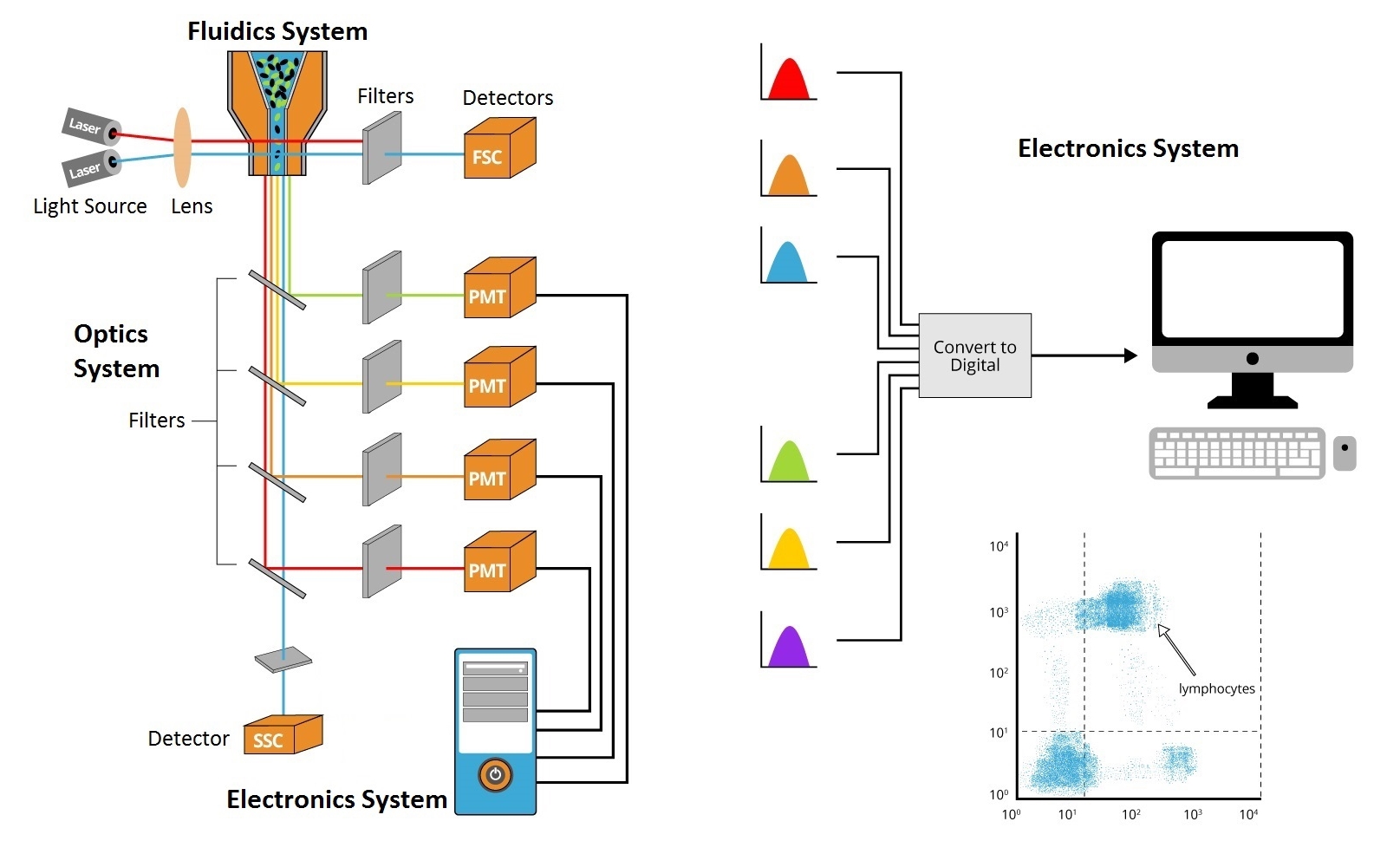Application of Flow Cytometry in Oncology

Flow cytometry has been widely used in clinical and basic laboratory for diagnostic and research purposes, since Mack Fulwyler first developed the flow cytometers in 1965. Flow cytometry is capable of measuring the optical and fluorescent characteristics of a single cell or any other particle such as microorganisms, nuclei, and chromosome prepared in a fluid stream when they pass through the light source. Subsequent advancements in the fields of computer science, laser technology, monoclonal antibody production, cytochemistry and fluorochrome chemistry enable simultaneous analysis of 20 features within an individual cell in a quantitative and qualitative manner. The parameters measured by flow cytometry include cell size, cytoplasmic complexity/granularity, nucleic acid content and various intracellular/membrane proteins.
The main components of flow cytometer are basic fluidics, optics (excitation and collection), electronic networks (detectors) and computers. The fluidics are responsible for directing liquid containing particles to the focused light source. The excitation optic focuses the light source on the cells/particles, while collection optic transmits the light scatter or fluorescent light of the particles to an electronic network. The electronic networks detect the signal and convert the signal to a digital data, which is proportional to the light intensity, and the computer is also required to analyze data.
The ability to simultaneously measure multiple cellular and molecular information within a single cell is probably the most powerful aspect of analytical flow cytometry. This allows flow cytometry to be used in the vast majority of hematological and oncological diseases.
 Figure 1. The main components of flow cytometry.
Figure 1. The main components of flow cytometry.
Preclinical Drug Discovery
Monitoring cell lines in vitro for induction of apoptosis and cell cycle arrest after compound exposure can help identify the in vivo models that will have a higher probability of success.
- Cell cycle analysis – Identification of cellular division stages.
- Cell proliferation – Identification and enumeration of cellular proliferation levels.
- Cell viability – Identification and numeration of dead (necrotic) and dying (apoptotic) cells.
- Cell phenotyping – Identification and enumeration of different types of cells in heterogeneous mixture.
- Cell signaling – Identification and enumeration of messaging within and between cell.
- Intracellular Cytokine Secretion (ICS) – Identification and enumeration of cells that are secreting factors (cytokines)
Preclinical Toxicology and Safety Evaluation
Post preclinical phase of drug development, questions such as efficacy, safety, and tolerability are critical to each drug program. These questions directly relate to preparedness towards human clinical trials and enable the design of trials to allow adequate benefit-risk profiles for normal healthy volunteers and patients.
- Identify changes in the number and percentage of cell types before and after treatment.
- Identify changes in biological (cellular) response before and after treatment by evaluating cell proliferation, cell signaling, cytokine secretion and other functional readouts.
- Identification of change in cellular signaling before and after treatment.
Clinical Flow Cytometry
Flow cytometry is most commonly used to indicate benign and malignant oncological processes. It can help in several clinical areas including diagnosis, treatment plans, and monitoring residual or recurrent disease. Peripheral blood, bone marrow aspirate and cerebrospinal fluid are all specimens that can be analyzed by flow cytometry.
- Analysis of leukemia and lymphoma disorders
- Detection of minimal residual disease (MRD)
- Measurement of the efficacy of cancer chemotherapy
- Stem cell enumeration
Flow cytometry is a versatile tool with great potential for the study of cells and particles. Due to its unique analytical capabilities, the flow cytometer has become an integral part of the medical research.
References
- Woo Janghee, et al.; Recent advancements of flow cytometry: new applications in hematology and oncology. Expert Rev. Mol. Diagn. 2014, 14(1): 67-81.
- Aysun Adan, et al.; Flow cytometry: basic principles and applications. Critical Reviews in Biotechnology, 2017, 37(2): 163-176.